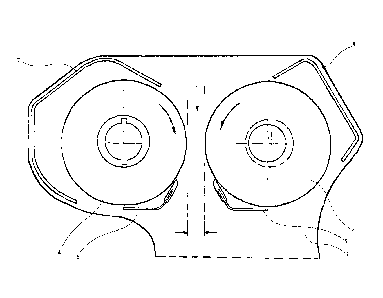Some of the information on this Web page has been provided by external sources. The Government of Canada is not responsible for the accuracy, reliability or currency of the information supplied by external sources. Users wishing to rely upon this information should consult directly with the source of the information. Content provided by external sources is not subject to official languages, privacy and accessibility requirements.
Any discrepancies in the text and image of the Claims and Abstract are due to differing posting times. Text of the Claims and Abstract are posted:
| (12) Patent: | (11) CA 2693424 |
|---|---|
| (54) English Title: | PASTA MACHINE FOR DOMESTIC USE WITH IMPROVED HOUSING |
| (54) French Title: | MACHINE A PATES POUR UTILISATION DOMESTIQUE A BOITIER AMELIORE |
| Status: | Expired and beyond the Period of Reversal |
| (51) International Patent Classification (IPC): |
|
|---|---|
| (72) Inventors : |
|
| (73) Owners : |
|
| (71) Applicants : |
|
| (74) Agent: | MACRAE & CO. |
| (74) Associate agent: | |
| (45) Issued: | 2015-06-16 |
| (86) PCT Filing Date: | 2008-07-28 |
| (87) Open to Public Inspection: | 2009-02-05 |
| Examination requested: | 2013-07-17 |
| Availability of licence: | N/A |
| Dedicated to the Public: | N/A |
| (25) Language of filing: | English |
| Patent Cooperation Treaty (PCT): | Yes |
|---|---|
| (86) PCT Filing Number: | PCT/IB2008/001969 |
| (87) International Publication Number: | WO 2009016465 |
| (85) National Entry: | 2010-01-12 |
| (30) Application Priority Data: | ||||||
|---|---|---|---|---|---|---|
|
The item in subject is a pasta machine for domestic use, in which the surfaces
10 of the various parts of of the cover
1, 2, 7, 8 are composed of a microporous layer of alluminium oxide and
completed with sealing 11 of the micropores for hydration
thus obtaining a micro-roughness with nonstick properties enabling the working
of moist pastry.
La présente invention concerne une machine à pâtes destinée à un usage domestique, dans laquelle les surfaces (10) des divers parties du couvercle (1, 2, 7, 8) sont composées d'une couche microporeuse d'oxyde d'aluminium et sur lesquelles les micropores sont scellés (11) pour l'hydratation, aboutissant ainsi à une microrugosité présentant des propriétés anti-adhérentes qui permettent de travailler des pâtes humides.
Note: Claims are shown in the official language in which they were submitted.
Note: Descriptions are shown in the official language in which they were submitted.

2024-08-01:As part of the Next Generation Patents (NGP) transition, the Canadian Patents Database (CPD) now contains a more detailed Event History, which replicates the Event Log of our new back-office solution.
Please note that "Inactive:" events refers to events no longer in use in our new back-office solution.
For a clearer understanding of the status of the application/patent presented on this page, the site Disclaimer , as well as the definitions for Patent , Event History , Maintenance Fee and Payment History should be consulted.
| Description | Date |
|---|---|
| Time Limit for Reversal Expired | 2019-07-29 |
| Letter Sent | 2018-07-30 |
| Maintenance Request Received | 2017-06-14 |
| Maintenance Request Received | 2016-07-11 |
| Grant by Issuance | 2015-06-16 |
| Inactive: Cover page published | 2015-06-15 |
| Pre-grant | 2015-03-31 |
| Inactive: Final fee received | 2015-03-31 |
| Notice of Allowance is Issued | 2015-02-04 |
| Letter Sent | 2015-02-04 |
| Notice of Allowance is Issued | 2015-02-04 |
| Inactive: Approved for allowance (AFA) | 2014-12-18 |
| Inactive: QS passed | 2014-12-18 |
| Amendment Received - Voluntary Amendment | 2014-12-04 |
| Inactive: S.30(2) Rules - Examiner requisition | 2014-06-06 |
| Inactive: Report - No QC | 2014-05-29 |
| Letter Sent | 2013-07-23 |
| Request for Examination Received | 2013-07-17 |
| Request for Examination Requirements Determined Compliant | 2013-07-17 |
| All Requirements for Examination Determined Compliant | 2013-07-17 |
| Inactive: Cover page published | 2010-03-26 |
| Inactive: Notice - National entry - No RFE | 2010-03-23 |
| Inactive: First IPC assigned | 2010-03-16 |
| Inactive: IPC assigned | 2010-03-16 |
| Inactive: IPC assigned | 2010-03-16 |
| Application Received - PCT | 2010-03-16 |
| National Entry Requirements Determined Compliant | 2010-01-12 |
| Application Published (Open to Public Inspection) | 2009-02-05 |
There is no abandonment history.
The last payment was received on 2014-07-21
Note : If the full payment has not been received on or before the date indicated, a further fee may be required which may be one of the following
Please refer to the CIPO Patent Fees web page to see all current fee amounts.
| Fee Type | Anniversary Year | Due Date | Paid Date |
|---|---|---|---|
| Basic national fee - standard | 2010-01-12 | ||
| MF (application, 2nd anniv.) - standard | 02 | 2010-07-28 | 2010-01-12 |
| MF (application, 3rd anniv.) - standard | 03 | 2011-07-28 | 2011-06-01 |
| MF (application, 4th anniv.) - standard | 04 | 2012-07-30 | 2012-06-07 |
| MF (application, 5th anniv.) - standard | 05 | 2013-07-29 | 2013-07-04 |
| Request for examination - standard | 2013-07-17 | ||
| MF (application, 6th anniv.) - standard | 06 | 2014-07-28 | 2014-07-21 |
| Final fee - standard | 2015-03-31 | ||
| MF (patent, 7th anniv.) - standard | 2015-07-28 | 2015-07-14 | |
| MF (patent, 8th anniv.) - standard | 2016-07-28 | 2016-07-11 | |
| MF (patent, 9th anniv.) - standard | 2017-07-28 | 2017-06-14 |
Note: Records showing the ownership history in alphabetical order.
| Current Owners on Record |
|---|
| MARCATO S.P.A. |
| Past Owners on Record |
|---|
| PIETRO MARCATO |